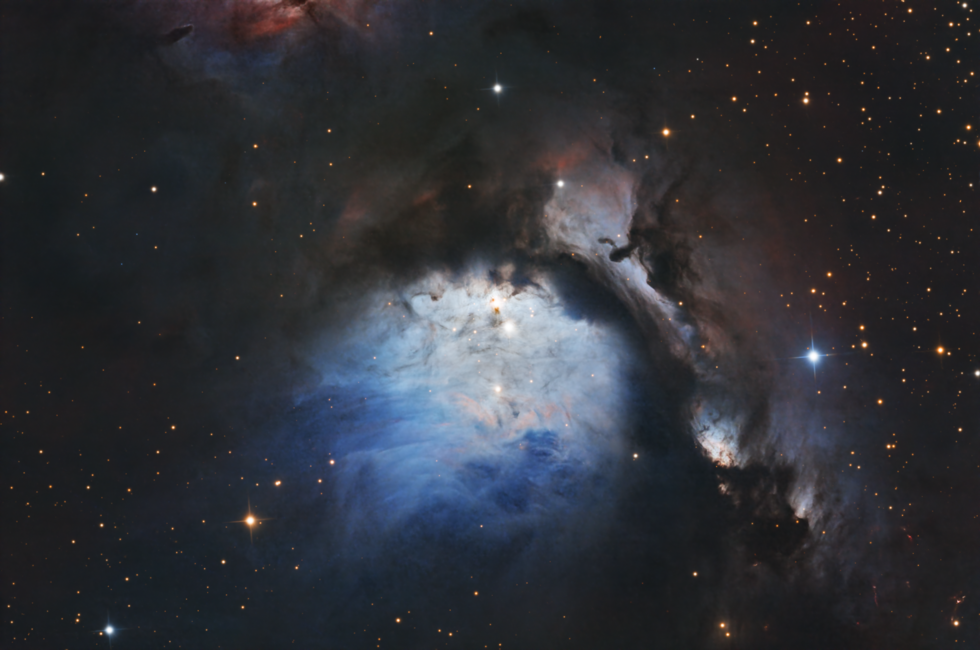Messier 78 LRGB
Messier 78 LRGB
This is a relatively small nebula which requires some subtle yet at the same time relatively aggressive post processing to pull out the colors that are present despite it being a reflection nebula (reflection nebula are almost exclusively Blue/Bluish, the Pleiades being the most prominent example most people are familiar with). My first attempt resulted in some unacceptable artifacts being created from trying to push the data more that it wanted to go. My second attempt avoided that issue and is posted here.
I used HDR to retrieve the details in the bright core while avoiding the burnout that typically reduces that part of the image to a white shape without internal structure. Kudo's again to the excellent tools from RC Astro - BXT, NXT, and SXT. It has become my normal workflow to separate out the stars and work with them separately from any nebula structures. This avoids the star bloat and color changes that inevitably occur if the entire image is processed together. Russ Croman's tools make what was once a bit of a tedious task into something simple.
A deeper / longer integration time dataset would make post processing a bit easier, but the quality of LRGB frames from CHI-1 are very good.
From Wikipedia:
Messier 78 or M78, also known as NGC 2068, is a reflection nebula in the constellationOrion. It was discovered by Pierre Méchain in 1780 and included by Charles Messier in his catalog of comet-like objects that same year.
M78 is the brightest diffuse reflection nebula of a group of nebulae that includes NGC 2064, NGC 2067 and NGC 2071. This group belongs to the Orion B molecular cloud complex and is about 1,350 light-years distant from Earth.
M78 is easily found in small telescopes as a hazy patch and involves two stars of 10th and 11th magnitude. These two B-type stars, HD 38563 A and H38563 B, are responsible for making the cloud of dust in M78 visible by reflecting their light.The M78 cloud contains a cluster of stars that is visible in the infrared. Due to gravity, the molecular gas in the nebula has fragmented into a hierarchy of clumps, whose cores have masses ranging from 0.3 M☉ to 5 M☉.
About 45 variable stars of the T Tauri type, young stars still in the process of formation, are members as well. Similarly, 17 Herbig–Haro objects are known in M78.
I used HDR to retrieve the details in the bright core while avoiding the burnout that typically reduces that part of the image to a white shape without internal structure. Kudo's again to the excellent tools from RC Astro - BXT, NXT, and SXT. It has become my normal workflow to separate out the stars and work with them separately from any nebula structures. This avoids the star bloat and color changes that inevitably occur if the entire image is processed together. Russ Croman's tools make what was once a bit of a tedious task into something simple.
A deeper / longer integration time dataset would make post processing a bit easier, but the quality of LRGB frames from CHI-1 are very good.
From Wikipedia:
Messier 78 or M78, also known as NGC 2068, is a reflection nebula in the constellationOrion. It was discovered by Pierre Méchain in 1780 and included by Charles Messier in his catalog of comet-like objects that same year.
M78 is the brightest diffuse reflection nebula of a group of nebulae that includes NGC 2064, NGC 2067 and NGC 2071. This group belongs to the Orion B molecular cloud complex and is about 1,350 light-years distant from Earth.
M78 is easily found in small telescopes as a hazy patch and involves two stars of 10th and 11th magnitude. These two B-type stars, HD 38563 A and H38563 B, are responsible for making the cloud of dust in M78 visible by reflecting their light.The M78 cloud contains a cluster of stars that is visible in the infrared. Due to gravity, the molecular gas in the nebula has fragmented into a hierarchy of clumps, whose cores have masses ranging from 0.3 M☉ to 5 M☉.
About 45 variable stars of the T Tauri type, young stars still in the process of formation, are members as well. Similarly, 17 Herbig–Haro objects are known in M78.
SPECIFICATIONS
Telescope
CHI-1 Planewave CDK24
Camera
QHY 600M
Location
El Sauce, Chile
Date of observation
12 2023
Filters
Astrondon L, R, G, B
Processing
PixInsight
Credits
Telescope Live


